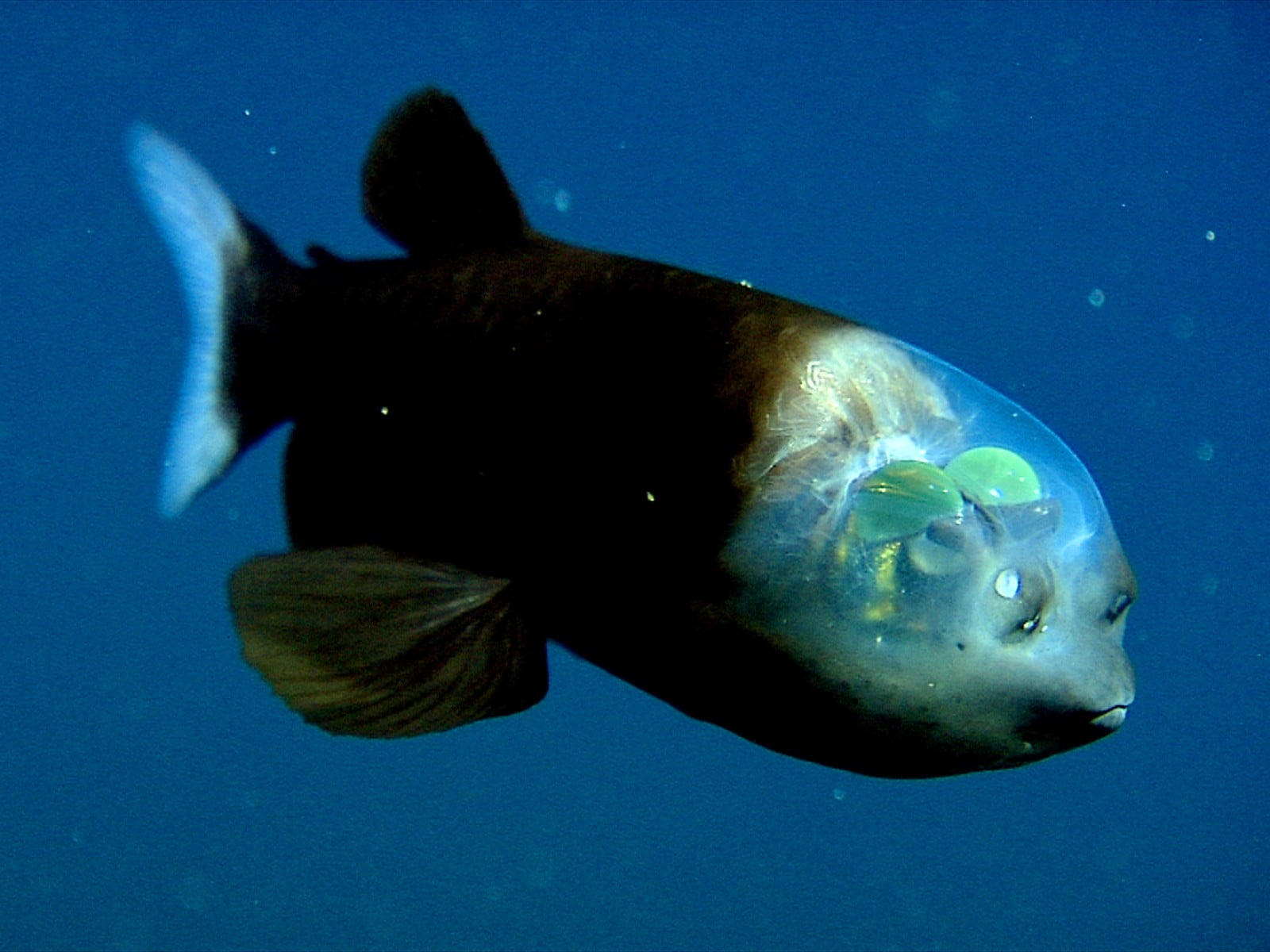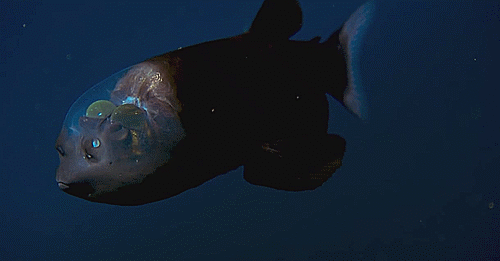The barreleye fish might look like a submarine, but its transparent head and tubular eyes are necessary to navigate the 2,500-feet-deep waters in which it dwells. And scientists have now solved the half-century-old mystery of how it uses them.
 The barreleye fish has tubular eyes that are extremely light-sensitive and can rotate within a transparent, fluid-filled shield on its head. The eyes point upward (as shown here) when the fish is looking for food overhead. They point forward when the fish is feeding. The two spots above the fish’s mouth are olfactory organs called nares, which are analogous to human nostrils. Photo: MBARI
The barreleye fish has tubular eyes that are extremely light-sensitive and can rotate within a transparent, fluid-filled shield on its head. The eyes point upward (as shown here) when the fish is looking for food overhead. They point forward when the fish is feeding. The two spots above the fish’s mouth are olfactory organs called nares, which are analogous to human nostrils. Photo: MBARI
At first glance, the barreleye fish (Macropinna microstoma) might look more like an alien creature than anything earthly. But the “spookfish” (as its more aptly known) is very much a real creature that lives deep in our oceans. It is considered by biologists to be one of the “most peculiar and unknown fish groups in the deep-sea pelagic realm.”
The name of the barreleye comes from the pair of tubular eyes embedded in its transparent head which looks like a deep ocean submarine with a large glass window. This unique physical setup is actually one that illuminates the abyss in which the barreleye lurks, making it an astute hunting tool.

Marine biologists used to know very little about this creature – until now. One thing they have known ever since the “barreleye” fish (Macropinna microstoma) was first described in 1939 is that its tubular eyes are very good at collecting light. However, they believed the eyes were fixed in place and provided only a “tunnel-vision” view of whatever was directly above the fish’s head.
Then, in 2009, researchers at the Monterey Bay Aquarium Research Institute (MBARI) were able to observe a live barreleye fish that was successfully brought to the surface for several hours. During their observation of the fish, biologists uncovered some shocking revelations.

The new paper by Bruce Robison and Kim Reisenbichler shows that these unusual eyes can rotate within a transparent shield that covers the fish’s head, allowing it to peer up at potential prey or focus forward to see what it is eating.
Deep-sea fish have adapted to their pitch-black environment in a variety of amazing ways. For example, researchers noticed that the eyes of the barreleye weren’t just strange-looking, they were also green. They believe the green coloring helps the fish filter out sunlight from the surface far above it. It also likely helps it spot the bioluminescent glow of its prey above.
Barreleyes typically live near the depth where sunlight from the surface fades to complete blackness. They use their ultra-sensitive tubular eyes to search for the faint silhouettes of prey overhead.
Although such tubular eyes are very good at collecting light, they have a very narrow field of view. As noted above, until now scientists believed that the barreleye’s eyes were fixed in their heads in a stare straight above them. This, however, would make it impossible for the fish to see what’s directly in front, and very difficult to capture prey with its small, pointed mouth.
And indeed: as it turns out, those eyes actually rotate. This led marine biologists to believe that the barreleye peers upwards to spot the faint shadows of its potential prey and then fixes its eyes forward as it slowly rises to meet its victim.
Regarding the barelleye’s strange, see-through head, researchers found that it was actually filled with a fluid forming a transparent shield. Earlier descriptions of the barreleye failed to mention its bubble head, most probably because it was destroyed when the fish was brought to the surface from the deep in nets.





